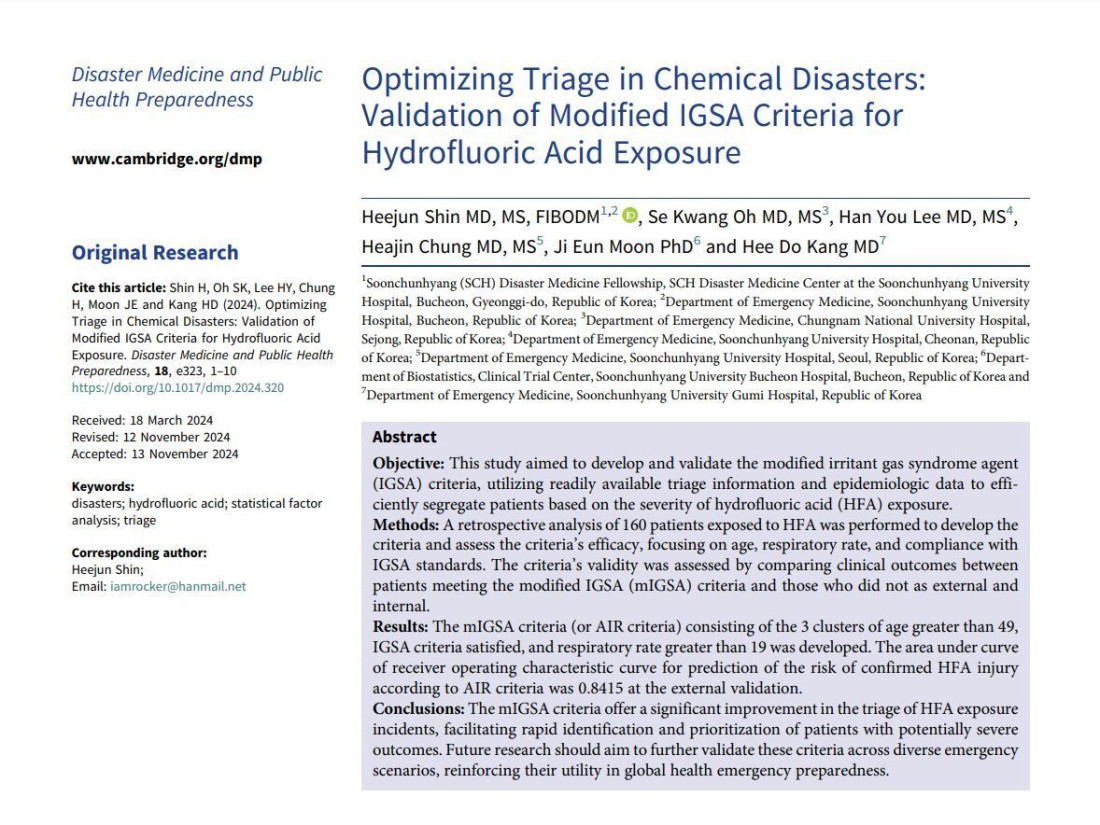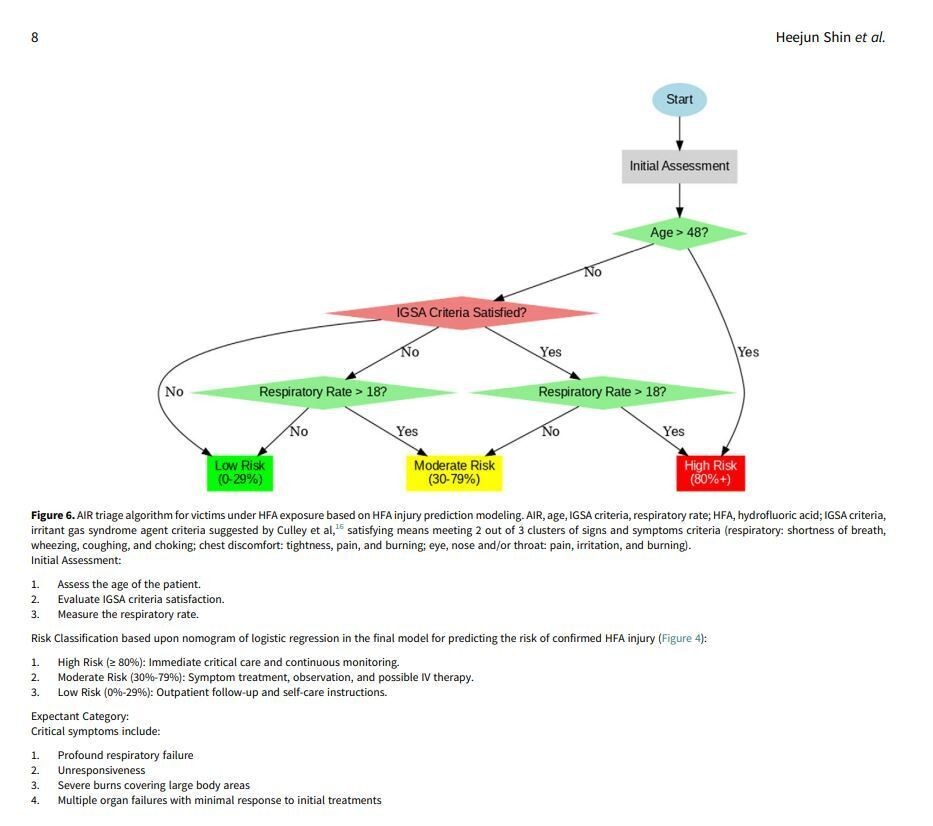January 2025
2025년 SCH 재난의학센터 학술 연구 및 논문 발간
Academic Research and Publication of the SCH Disaster Medicine Center in 2025
2025년 1월 3일, SCH 재난의학센터 재난의학 펠로우쉽 1호 논문 발간
Cambridge University Press SCIE 학술지 Disaster Medicine and Public Health Preparedness에 논문 발간
- 재난의학센터 논문 “Optimizing Triage in Chemical Disaster: Validation of Modified IGSA Criteria for Hydrofluoric Acid Exposure” 발간
- 연구 의의: AIR Triage (or The modified IGSA criteria)라고 명명한 화학 재난 대응을 위한 체계적 선별 진료 도구를 제안 및 validation 하여 산업에서 다양한 용도로 많이 사용되는 불산의 흡입 노출 다수 사상환자가 발생했을 때 병원 전 단계에서 중증환자의 빠른 선별과 우선 이송에 기여하고 병원 단계에서는 응급실 포함 다수 사상환자가 밀려올 때 초기 환자의 나이, 증상 및 징후, 분당 호흡수 만을 가지고도 재난 중증도를 분류하여 병원 응급실 자원의 효율적 사용과 신속한 환자 치료에 기여
January 3, 2025: Publication of the First Fellowship Research Paper by the SCH Disaster Medicine Center
The SCH Disaster Medicine Center proudly announces the publication of its first fellowship research paper in the SCIE journal Disaster Medicine and Public Health Preparedness by Cambridge University Press.
Key Details of the Research Paper:
Title: "Optimizing Triage in Chemical Disaster: Validation of Modified IGSA Criteria for Hydrofluoric Acid Exposure"
Significance of the Study:
Introduces and validates a systematic triage tool named AIR Triage (also referred to as the modified IGSA criteria) for chemical disaster response.
Focuses on hydrofluoric acid (HF) inhalation exposure, a chemical widely used in various industries, addressing scenarios involving multiple casualties.
- Pre-Hospital Phase:
Enhances rapid identification of severe cases and prioritization of transport during mass casualty incidents involving HF exposure.
- Hospital Phase:
Provides a method to categorize disaster severity based on initial patient data (age, symptoms, signs, and respiratory rate) during emergency department (ED) surges.
Facilitates efficient resource allocation in EDs, enabling prompt treatment of patients during chemical disasters.
This groundbreaking study demonstrates the SCH Disaster Medicine Center's commitment to advancing disaster medicine and establishing evidence-based tools for effective disas
순천향대 부천병원 재난의학센터,
불산 흡입 노출 환자의 중증도 분류를 위한 새 기준 개발
■ AIR 기준(수정된 IGSA 기준) 개발 및 검증ⵈ 잠재적 중증 환자 신속 선별 가능
■ 의료 자원의 효율적 배분과 환자 생존율 향상에 기여할 것
순천향대 부천병원 응급의학과 신희준 교수 연구팀(충남대학교병원 응급의학과 오세광 교수, 순천향대학교 천안병원 응급의학과 이한유 교수, 순천향대학교 서울병원 응급의학과 정혜진 교수)이 최근 불산 흡입 노출 환자의 중증도를 신속하게 판단할 수 있는 새로운 분류 기준을 개발했다고 14일 밝혔다.
이번 연구는 재난의학 분야 국제 학술지 ‘Disaster Medicine and Public Health Preparedness(IF: 1.9)’에 게재되었다.
불산은 전자제품 제조 및 공업 분야에서 널리 사용되는 화학 물질로, 인체에 노출 시 눈, 피부, 호흡기 등에 심각한 화학적 손상을 유발할 수 있다. 연구팀은 머신러닝 알고리즘을 활용해 2012년 구미시 화학공장 불산 누출 사고 불산 노출 환자 160명의 임상 데이터를 분석해 ‘수정된 IGSA(자극성 기체 증후군 제제, mIGSA) 기준’을 개발했다.
이 기준은 ▲연령 49세 이상 ▲분당 호흡수 19회 이상 ▲호흡곤란, 가슴 통증 등 주요 증상 두 가지 이상 충족 등(기존 IGSA 기준 충족 여부)의 세 가지 요소로 구성되며, 이 중 두 가지 이상을 충족하면 중증 위험이 높은 것으로 판단한다. 연구팀은 이 기준을 통해 환자의 상태를 즉시 치료가 필요한 고위험, 증상을 관찰하며 치료할 중간 위험, 외래 진료와 관리가 가능한 저위험으로 분류했다. 기준의 정확도 검증 결과, 위험도의 예측 정확도는 약 84%로, 불산 노출 환자의 중증도를 효과적으로 분류할 수 있는 것으로 나타났다.
신희준 순천향대 부천병원 재난의학센터장(응급의학과 교수)는 “이번 연구는 실제 환자 데이터를 기반으로 머신러닝 기법을 활용해 화학 재난 대응을 위한 체계적 선별 진료 기준을 개발하고 검증한 세계 첫 연구다. 불의의 화학 재난 발생 시 의료 자원의 효율적 분배 및 환자 생존율 향상에 기여할 것으로 예상된다”고 밝혔다.
이어 “이번 연구 결과가 화학 재해 대응 시스템의 혁신적 전환점이 되어, 국제적인 화학 재해 대응 체계의 핵심 도구로 자리 잡기를 기대한다. 이번 연구 결과를 기반으로 향후 더 다양한 화학 재해 상황에 적용할 수 있는 글로벌 표준 개발에 앞장설 것”이라고 덧붙였다.
Soonchunhyang University Bucheon Hospital Disaster Medicine Center
Development of a New Triage Criteria for Hydrofluoric Acid Inhalation Exposure Patients
Development and Validation of the AIR Criteria (Modified IGSA Criteria): Enables Rapid Identification of Potentially Severe Cases
Contributes to Efficient Allocation of Medical Resources and Improved Patient Survival Rates
Professor Heejun Shin’s research team from the Department of Emergency Medicine at Soonchunhyang University Bucheon Hospital (including Professor Sekwang Oh from Chungnam National University Hospital, Professor Hanyu Lee from Soonchunhyang University Cheonan Hospital, and Professor Hyejin Jung from Soonchunhyang University Seoul Hospital) announced on the 14th that they have developed new triage criteria for rapidly assessing the severity of hydrofluoric acid inhalation exposure patients.
This study was published in the international disaster medicine journal Disaster Medicine and Public Health Preparedness (Impact Factor: 1.9).
Hydrofluoric acid is a chemical widely used in the electronics manufacturing and industrial sectors. Exposure to it can cause severe chemical injuries to the eyes, skin, and respiratory system. Using machine learning algorithms, the research team analyzed the clinical data of 160 patients exposed to hydrofluoric acid during the 2012 hydrofluoric acid leak incident at a chemical plant in Gumi, South Korea. Based on this analysis, they developed the "Modified IGSA (Irritant Gas Syndrome Agent) Criteria," also referred to as the AIR criteria.
The criteria consist of three elements:
Age ≥ 49 years,
Respiratory rate ≥ 19 breaths per minute,
Presence of at least two major symptoms such as dyspnea or chest pain.
Patients meeting at least two of these elements are classified as high-risk. Using this criteria, patients can be categorized into three groups:
High-risk: Requiring immediate treatment.
Moderate-risk: Requiring observation and treatment.
Low-risk: Suitable for outpatient care and management.
Validation results showed an 84% accuracy in predicting risk levels, demonstrating the criteria’s effectiveness in triaging hydrofluoric acid exposure patients.
Professor Heejun Shin, Director of the Disaster Medicine Center at Soonchunhyang University Bucheon Hospital (Department of Emergency Medicine), stated, “This study is the world’s first to develop and validate systematic triage criteria for chemical disaster response using actual patient data and machine learning techniques. It is expected to contribute significantly to the efficient allocation of medical resources and improved patient survival rates in unexpected chemical disasters.”
He added, “We hope this study will serve as a transformative milestone in chemical disaster response systems and become a key tool in global chemical disaster preparedness. Building on these findings, we will lead the development of global standards applicable to a wider range of chemical disaster scenarios.”
WADEM 2025 ToKyo Conference 초록 9편 모두 채택
Acceptance of All 9 Abstracts of SCH Disaster Medicine Center by the WADEM 2025 Tokyo Conference
2025년 일본 도쿄 재난의학 컨퍼런스 WADEM 2025 ToKyo Conference 초록 9편 모두 채택
- 라이트닝 구연 발표 (5 슬라이드 , 5분 구연) 2편
1. 2000년부터 2024년까지 한국의 대형 재난에 대한 종합 분석
2. 시계열 분석을 활용한 군사 표적 테러 예측 기술
- 포스터 발표 7편
3. 1970년부터 2020년까지 테러 사건에서 화학 무기 사용의 지리적 분포와 시간적 분석
4. 군사 기관을 표적으로 하는 테러 단체의 주요 연계 및 파괴 전략을 파악하기 위한 AI 기반 네트워크 분석
5. 1970년부터 2020년까지 군사 테러의 전 세계적 분석: 사건, 영향 및 경향
6. 시리아 내 의료 시설 공격의 사망률 및 부상률 예측: 베이지안 릿지 회귀 접근법
7. 1970년부터 2020년까지 경찰력을 대상으로 한 글로벌 테러 공격의 발생률 및 영향
8. 응급실 효율성 향상을 위한 품질 개선 이니셔티브: 환자 흐름 최적화 및 중증 치료 자원 활용
9. AI 기반 예측 모델링을 통한 불산 노출 예후 분석: 개별 참가자 데이터를 활용한 체계적 메타 분석
- Lightening Presentation (2)
1. Comprehensive Analysis of Millenium Disasters in South Korea from 2000 to 2024
2. Advanced Forecasting of Military-Targeted Terrorism Using Time Series Analysis
- Poster Presentation (7)
3. Geographical Distribution and Temporal Analysis of Chemical Weapon Usage in Terrorist Events from 1970 to 2020
4. AI-Enhanced Network Analysis of Terrorist Groups Targeting Military Entities: Identifying Key Interconnections and Disruptive Strategies
5. Global Analysis of Military Terrorism: Incidents, Impact, and Trends from 1970 to 2020
6. Predicting Mortality and Injury Rates in Healthcare Facility Attacks in Syria: A Bayesian Ridge Regression Approach
7. The Prevalence and Impact of Global Terrorist Attacks on Police Forces from 1970 through 2020
8. Enhancing Emergency Department Efficiency: A Quality Improvement Initiative to Optimize Patient Flow and Critical Care Utilization
9. AI-Based Predictive Modeling for Prognosis of Hydrofluoric Acid Exposure: A Systematic Meta-Analysis of Individual Participant Data (Poster Presentation
총 9편 중에서 2 편은 Lightening Presentation 이며 7편은 Poster Presentation 으로 선정됨
특히, 그중 두 개는 높은 경쟁률을 자랑하는 라이트닝 발표(5분, 5슬라이드로 진행되는 간결하고 강렬한 구연 발표)로 선정되었음 (모두 신희준 센터장 발표):
1. "2000년부터 2024년까지 대한민국의 밀레니엄 재난에 대한 종합 분석"
본 연구는 지난 20여 년간 대한민국의 재난 데이터를 심층적으로 분석하며, 재난의 심각성과 빈도가 증가하고 있음을 보여줍니다. 자연재해와 기술재해의 추세를 철저한 통계 및 회귀분석을 통해 도출하며, 재난 회복력을 강화하기 위한 정책 개선과 기술 혁신의 필요성을 강조하고 있습니다.
2. "군사 목표 테러의 고도 예측: 시계열 분석의 적용"
첨단 머신러닝 기법(LSTM 네트워크 등)을 활용하여 군사 목표 테러의 미래 추세를 예측하는 선구적인 연구입니다.
본 연구는 정책 입안자와 국방 전략가들에게 귀중한 통찰을 제공하며, 첨단 기술이 복잡한 안보 문제를 해결하고 글로벌 안정을 증진하는 데 어떻게 기여할 수 있는지를 보여줍니다.
이와 더불어, 7개의 초록이 포스터 발표로 선정되었으며, 다양한 주제와 혁신적인 연구 성과를 소개할 예정입니다.
또한 이들 초록 중 순천향부천 응급의료센터 간호부이자 SCH 재난의학센터 강사인 "노지영" 선생님께서 재난 간호부의 저력을 보여준 QI 주제
"Enhancing Emergency Department Efficiency: A Quality Improvement Initiative to Optimize Patient Flow and Critical Care Utilization" 초록으로
2년 마다 열리는 전 세계 최고의 재난의학 컨퍼런스에서 저와함께 발표하게 되었음.
Out of the total of nine abstracts, two have been selected for Lightning Presentations, and seven for Poster Presentations.
Lightning Presentations (both presented by Heejun Shin):
Lightning Presentations are concise and impactful oral presentations conducted in 5 minutes with 5 slides. Both selected abstracts are notable for their competitive selection:
"Comprehensive Analysis of Millennium Disasters in South Korea from 2000 to 2024"
This study provides an in-depth analysis of disaster data in South Korea over the past two decades, revealing an increasing severity and frequency of disasters. Through rigorous statistical and regression analysis, it identifies trends in natural and technological disasters, emphasizing the need for policy improvements and technological innovations to enhance disaster resilience.
"Advanced Forecasting of Military-Targeted Terrorism Using Time Series Analysis"
This pioneering study utilizes advanced machine learning techniques, such as LSTM networks, to predict future trends in military-targeted terrorism. The research offers valuable insights for policymakers and defense strategists, demonstrating how cutting-edge technology can address complex security challenges and promote global stability.
Poster Presentations:
Additionally, seven abstracts have been selected for poster presentations, showcasing diverse topics and innovative research achievements.
Among these, Roh Jiyoung, a nurse at Soonchunhyang Bucheon Emergency Medical Center and one of our disaster medicine instructors, will join me in presenting her poster, "Enhancing Emergency Department Efficiency: A Quality Improvement Initiative to Optimize Patient Flow and Critical Care Utilization."
This abstract, which highlights the strength of our nursing department, will be presented at the world’s premier disaster medicine conference held every two years. It serves as a testament to our commitment to excellence and innovation in disaster medicine











